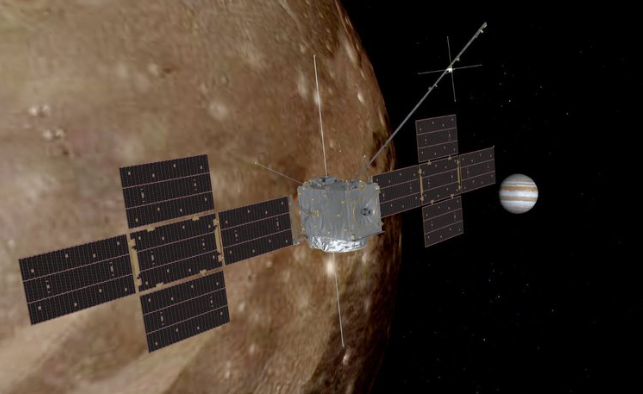Impact Crater Evidence: Scientists have identified features on Ganymede’s surface that indicate a massive impact occurred in its distant past. This impact likely reshaped large portions of the moon’s surface, creating large-scale terrain deformations.
Formation of Grooved Terrain: Ganymede’s surface is characterized by two main types of terrain: dark, older regions and lighter, younger grooved regions. The grooves are believed to have formed as a result of tectonic activity following the asteroid impact. This impact likely created a shockwave that fractured the ice shell, leading to the creation of these grooved terrains.
A colossal asteroid, believed to be 20 times larger than the one that may have caused the extinction of the dinosaurs, struck Jupiter’s moon Ganymede around 4 billion years ago, significantly altering the moon’s axis, according to a new study. This discovery sheds light on the dramatic events that shaped Ganymede, a moon larger than the planet Mercury and famous for its subsurface oceans, which may harbor life.
Gigantic asteroid impact shifted the axis of solar system’s biggest moon, study finds
— ken crichlow (@ken_crichlow) September 3, 2024
Ganymede’s surface is marked by furrows that form concentric circles around a central point. Since the 1980s, scientists have suspected that these formations were the result of a massive asteroid impact, but the full extent and consequences of the collision were not well understood. Hirata Naoyuki, a planetologist from Kobe University, explained, “These giant impacts are believed to have been frequent in the early solar system. This impact would affect the interior structure of Ganymede significantly, because the size of the transient crater reaches 25 percent of the size of Ganymede.”
- Size of the Impact: The asteroid that struck Ganymede is thought to have been quite large, potentially several tens of kilometers in diameter. The energy released by such an impact would have been immense, possibly enough to significantly alter the moon’s crust and trigger tectonic activity.
- Internal Geological Activity: The study suggests that the impact might have also caused internal geological changes. Ganymede, unlike many moons, has a differentiated interior, with a metallic core, a rocky mantle, and an icy crust. The impact could have triggered or accelerated internal processes, such as the upwelling of subsurface material.
Hirata’s research, published in the journal Scientific Reports, revealed that the impact site is nearly directly opposite Jupiter on Ganymede’s meridian. This observation led him to conclude that the impact was strong enough to shift Ganymede’s rotational axis, a phenomenon similar to the axis shift observed on Pluto after a significant impact, as noted by the New Horizons space probe.
Simulations of the impact suggest that the asteroid responsible was approximately 190 miles in diameter, making it about 20 times larger than the asteroid that struck Earth 65 million years ago. This impact created a transient crater on Ganymede’s surface, estimated to be between 870 miles and 1,000 miles in diameter. These transient craters are the initial cavities formed immediately after an impact, before the surrounding material settles.
- Implications for Planetary Science: Understanding this impact event helps scientists learn more about the history and evolution of the outer solar system’s moons. It also offers insights into the processes that shape icy bodies and their potential for tectonic and cryovolcanic activity.
- Methods Used: Researchers used a combination of spacecraft data, particularly from NASA’s Galileo mission, and computer simulations to reconstruct the impact event and its effects on Ganymede. The simulations helped them understand how the impact might have propagated through the moon’s ice and rock layers.
Hirata highlighted that the impact likely had a profound effect on Ganymede’s early evolution, though the thermal and structural effects on the moon’s interior have yet to be fully explored. Ganymede’s intriguing characteristics, including its vast subsurface ocean—which could potentially harbor life—make it a key target for future space exploration. NASA’s Hubble Space Telescope provided evidence in 2015 that Ganymede’s underground ocean might be about 60 miles deep, which is 10 times deeper than Earth’s oceans.
Solar System’s Largest Moon Was Shifted by Giant Asteroid Impact, Study Says https://t.co/IQHX5dq4V4 pic.twitter.com/CktQBwuuZq
— iTekHost (@itekhost) September 3, 2024
Looking forward, the European Space Agency’s JUICE (JUpiter ICy moons Explorer) mission is set to arrive at Ganymede in 2034. The mission will spend six months in orbit around the moon, gathering data that could provide more answers about Ganymede’s history and the effects of the ancient asteroid impact. Hirata expressed excitement about the upcoming mission, stating, “Future explorations—in particular, the JUICE mission—will reveal topographic profiles or gravity anomalies associated with the impact, which would provide insights into this giant impact and Ganymede’s early history.”
Key Points:
i. An asteroid 20 times larger than the one that possibly wiped out the dinosaurs struck Ganymede, Jupiter’s moon, around 4 billion years ago.
ii. This massive impact likely shifted Ganymede’s rotational axis, altering its geological history.
iii. The impact created a crater between 870 and 1,000 miles in diameter, impacting 25% of Ganymede’s surface.
iv. Ganymede’s subsurface ocean, much deeper than Earth’s, makes it a prime candidate for future exploration.
v. The European Space Agency’s JUICE mission will investigate Ganymede further, arriving in 2034 to gather new data on the moon’s surface and interior.
Susan Guglielmo – Reprinted with permission of Whatfinger News



